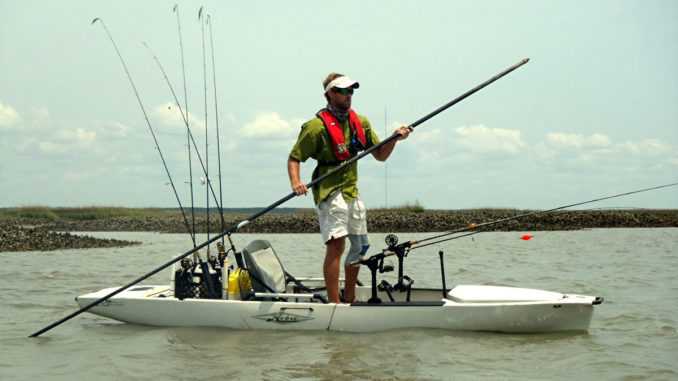
Propulsion methods should match fishing roles
When the chance to contribute a kayaking column in South Carolina Sportsman presented itself, I jumped at the opportunity. I did not establish the name of the column and deferred to the editors for the naming rights. It’s all about paddling anyway, right?
In real-time practice, however, the kayaking community is somewhat divided in the choices of propulsion for their angling craft. Here’s how it sorts out. If you’re a canoeist, you paddle; ditto for a large percentage of kayakers. However, there are other means of locomotion that don’t involve paddles.
Saturday Mel — that’s his real name — is an avid kayak angler from Hendersonville, N.C., and a member of the Upstate Kayak Fishing Club. He doesn’t get hung up on boat brands or methods of propulsion. He’s not a Ford vs. Chevy guy. He owns both a Wilderness Systems Ride 135, a paddle boat, and a Hobie Pro Angler 14, a pedal boat. Mel said that the waters he’ll be fishing and the tactics he’ll be using dictate which boat goes in the back of the truck on any given day.
“I own two different boats, and I love both of them,” Mel said. “One is good for some conditions, and the other is better for others, but with a choice of two style of boats, I have options, and I can fish just about anywhere and for anything I want.”
Mel touts the paddle boat for finesse fishing, such as drop-shotting or fishing shakey head jigs in water that’s 15 to 20 feet deep. For him, the paddle boat is more maneuverable.
“I can stay on my spot better in the Ride, because I can back-paddle or side-paddle,” he said, “especially if the wind is blowing. In the Hobie, I’d have to pedal in circles or anchor out.”
On the other hand, Mel loves his Hobie for power fishing, covering lots of water and trolling. He said he doesn’t have to coordinate when he’s going to cast with when he’s going to paddle because of the hands-free propulsion.
“With the Hobie, I just go,” he said. “I’m free to cast and cover a lot of water. Trolling is also a no-brainer. I don’t have to lay the paddle down to set the hook on a fish. I have missed fish before I got the Hobie because I was messing with the paddle.”
Though few anglers would ever venture far from the landing with only a push pole, many kayak anglers use push poles to maneuver their kayaks after they’ve either paddled or pedaled to their fishing location, typically a tailing flat somewhere along the South Carolina coast. Justin Carter of KayakFish SC, a fishing guide in Charleston, said push poles work like a charm for maneuvering across shallow flats.
“Superstick, which is made just up the road in Pawley’s Island, makes a downsized push pole that can turn a kayak into a premier flats boat,” said Carter (843-725-8784). “You need a boat that’s stable enough to stand up in; it doesn’t matter what style. Stow the paddle or take out the pedal drive, and you can be poling and casting the flats for tailing reds with the best of them.”
On the other side of the pedal/paddle debate is a rising number of fishermen who love the up close and personal style of fishing offered by a kayak but can’t or don’t want to propel the boat themselves. Within this segment of the kayak community, electric propulsion is becoming more mainstream.
Luther Cifers of Yak Attack kayak-fishing accessories is one of the most innovative and influential members of today’s kayak community. Of late, Cifers has been bridging the gap between paddling anglers and electric-powered craft. Cifers noticed that the large center scupper area of his Jackson Big Tuna, a paddle boat, provided ample space to integrate an all-in-one trolling motor, battery, sonar transducer and depth finder. While several “add-on” electric trolling motors were already available as after-market accessories, Cifer’s Big Tuna project is more in line with traditional pedal/paddle designs.
“We’re building an all-in-one, integrated battery/motor/depth finder solution that is easily installed and removed,” said Cifers. “I believe electric propulsion has a substantial place in the growth of kayak fishing. We’re seeing more and more kayak anglers who are more ‘angler’ than ‘kayak,’ and although there is some resistance within the industry to non-human-powered kayaks, we exist to serve the marketplace, and this is a segment of the market that I think we can bring some unique solutions to. Plus we like to play, and this is playing at its finest. The bigger picture is yet to be painted, but this is a great R&D stepping stone.”
Though Cifhers’ Big Tuna project is still in the R&D phase, needing to overcome such obstacles as balancing battery life with weight and designing a more waterproof housing, he foresees vast potential in this design and others that will have a more widespread application.
“We’re creating a different product that will fit almost any kayak,” he said. “The one for the Big Tuna requires the large passage in the center, but we have another design that does not.”




Be the first to comment